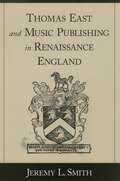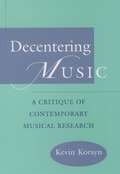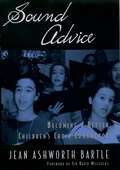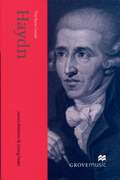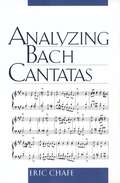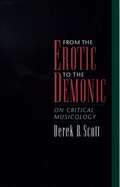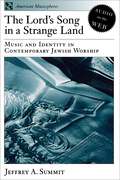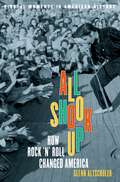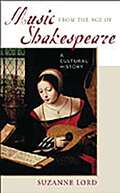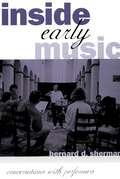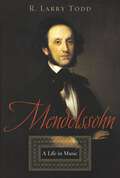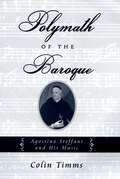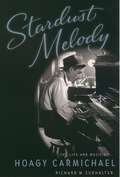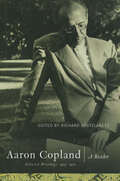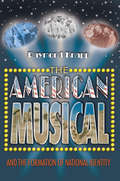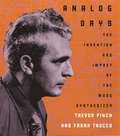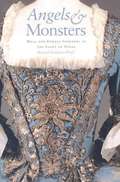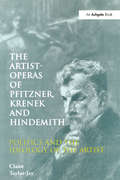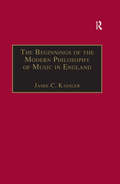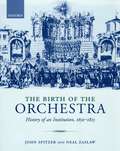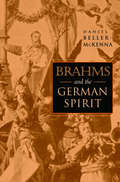- Table View
- List View
Thomas East and Music Publishing in Renaissance England
by Jeremy L. SmithIn the London of Shakespeare and William Byrd, Thomas East was the premier, often exclusive, printer of music. As he tells the story of this influential figure in early English music publishing, Jeremy Smith also offers a vivid overall portrait of a bustling and competitive industry, in which composers, patrons, publishers, and tradesmen sparred for creative control and financial success. It provides a truly comprehensive study of music publishing and a new way of understanding the place of musical culture in Elizabethan times. In addition, Smith has compiled the first complete chronology of East's music prints, based on both bibliographical and paper-based evidence.
Decentering Music: A Critique of Contemporary Musical Research
by Kevin KorsynAs a work of cultural criticism that recalls the concerns of Foucault, Hayden White, Zizek, and others Decentering Music examines the struggle for the authority to speak about music at a time when the humanities are in crisis. By linking the institutions that support musical research, including professional associations and universities, to complex historical changes such as globalization and the commodification of knowledge, Korsyn undertakes a critique of musical scholarship as an institutional discourse, while contributing to a general theory of disciplinary structures that goes beyond the limits of any single field. In asking a number of fundamental questions about the models through which disciplinary objects in music are constructed, Korsyn suggests unexpected relationships between works of musical scholarship and the cultural networks in which they participate. Thus David Lewin's theory of musical perceptions is compared to Richard Rorty's concept of the "liberal ironist," Susan McClary's feminist narrative of music history is juxtaposed with T.S. Eliot's "dissociation of sensibility," and Steven Feld's work in recording the music of the Kaluli people is compared to the treatment of ambient sound in contemporary cinema. Developing a framework for interpretation in dialogue with a number of poststructuralist writers, Korsyn goes far beyond applying their thought to the analysis of music; by showing the cultural dilemmas to which their work responds, Korsyn suggests how musical research already participates in these ideas. Rather than impose any single method, Decentering Music empowers readers to choose for themselves by interrogating their own values and ideological commitments, exploring the enabling conditions for statements about music. By demonstrating the complicity of opposing positions and challenging readers to reexamine their own values, Decentering Music will surely provoke debate, while appealing to readers in a variety of fields, and to anyone concerned about the crisis in the humanities.
Sound Advice: Becoming a Better Children's Choir Conductor
by Jean Ashworth BartleSound Advice is a valuable resource for college students, beginning teachers, and experienced conductors of children's choirs. It covers the vast array of skills needed by today's conductor and will benefit all choir directors who want their choirs to reach a higher level of artistry. This book will be useful on many levels: for the college student studying the child voice and elementary teaching methods; for the teacher beginning to direct choirs in schools, synagogues, churches and communities; for experienced children's choir directors who wish to know more about orchestral repertoire for treble voices, conducting an orchestra, and preparing a children's choir to sing a major work with a professional orchestra. The underlying educational philosophy is sound; the author sees development of musicianship through singing as the primary goal of a children's choir program. This philosophy differs dramatically from the traditional concept of the conductor as all-knowing and the singers as receptacles. An outstanding aspect of the book is how the author leads the reader to an understanding of how to teach musicianship. Developing literacy in the choral setting is a mysterious, amorphous process to many conductors, but the author clearly outlines this important process with practical suggestions, well-documented examples, and a clear reading style which will reach readers on many levels. The comprehensive repertoire, skill-building sheets, and programs for all types of children's choirs will provide teachers with immediate and highly valuable resources.
The New Grove Haydn (Grove Music Composer Biography Series)
The son of an 18th century Austrian wheelwright, Haydn is acknowledged for refining the symphony and string quartet and praised for his oratorios and masses. Deeply involved in the evolution of the Classical style, its subsequent growth can be seen in his own music. Indeed, he is considered to be one of the most significant composers of the Classical Period. Under his care the symphony and string quartet came to life, and the oratios and masses of his late years belong to the consummation of the classical spirit in music. This biography of Joseph Haydn is one in a new series of composer biographies, derived and adapted from the second edition of The New Grove Dictionary of Music and Musicians. These newly written biographies bring the best of the book-length pieces in The New Grove to a wider audience. Each title provides fresh new insights into the life and works of a major composer, derived from the most recent scholarship. In addition to a detailed and informative view of the subject's life and works, written by an expert in the field, each book includes comprehensive, tabular work-lists and a fully revised and updated bibliography.
Analyzing Bach Cantatas
by Eric ChafeBach's cantatas are among the highest achievements of Western musical art, yet studies of the individual cantatas that are both illuminating and detailed are few. In this book, noted Bach expert Eric Chafe combines theological, historical, analytical, and interpretive approaches to the cantatas to offer readers and listeners alike the richest possible experience of these works. A respected theorist of seventeenth-century music, Chafe is sensitive to the composer's intentions and to the enduring and universal qualities of the music itself. Concentrating on a small number of representative cantatas, mostly from the Leipzig cycles of 1723-24 and 1724-25, and in particular on Cantata 77, Chafe shows how Bach strove to mirror both the dogma and the mystery of religious experience in musical allegory. Analyzing Bach Cantatas offers valuable information on the theological relevance of the structure of the liturgical year for the design and content of these works, as well as a survey of the theories of modality that inform Bach's compositional style. Chafe demonstrates that, while Bach certainly employed "pictorialism" and word-painting in his compositions, his method of writing music was a more complex amalgam of theological concepts and music theory. Regarding the cantatas as musical allegories that reflect the fundamental tenets of Lutheran theology as established during Bach's lifetime, Chafe synthesizes a number of key musical and theological ideas to illuminate the essential character of these great works. This unique and insightful book offers an essential methodology for understanding one of the central bodies of work in the Western musical canon. It will prove indispensable for all students and scholars of Bach's work, musicology, and theological studies.
From the Erotic to the Demonic: On Critical Musicology
by Derek B. ScottFrom the Erotic to the Demonic demonstrates how different musical styles construct ideas of class, sexuality, and ethnic identity. This book will serve as a model for musicologists who want to take a postmodern approach to their inquiries. The clear and lively arguments are supported by ninety musical examples taken from such diverse sources as opera, symphonic music, jazz, and nineteenth- and twentieth-century popular songs. Derek Scott offers new insights on a range of "high" and "low" musical styles, and the cultures that produced them.
The Lord's Song in a Strange Land: Music and Identity in Contemporary Jewish Worship (American Musicspheres)
by Jeffrey A. SummitAcross the United States, Jews come together every week to sing and pray in a wide variety of worship communities. Through this music, made by and for ordinary folk, these worshippers define and re-define their relationship to the continuity of Jewish tradition and the realities of American life. Combining oral history with an analysis of recordings, The Lord's Song in a Strange Land examines this tradition incontemporary Jewish worship and explores the diverse links between the music and both spiritual and cultural identities. Alive with detail, the book focuses on metropolitan Boston and covers the full range of Jewish communities there, from Hasidim to Jewish college students in a transdenominational setting. It documents a remarkably fluid musical tradition, where melodies are often shared, where sources can be as diverse as Sufi chant, Christmas carols, rock and roll, and Israeli popular music, and where the meaning of a song can change from one block to the next.
All Shook Up: How Rock 'n' Roll Changed America (Pivotal Moments in American History)
by Glenn C. AltschulerThe birth of rock 'n roll ignited a firestorm of controversy--one critic called it "musical riots put to a switchblade beat"--but if it generated much sound and fury, what, if anything, did it signify? As Glenn Altschuler reveals in All Shook Up, the rise of rock 'n roll--and the outraged reception to it--in fact can tell us a lot about the values of the United States in the 1950s, a decade that saw a great struggle for the control of popular culture. Altschuler shows, in particular, how rock's "switchblade beat" opened up wide fissures in American society along the fault-lines of family, sexuality, and race. For instance, the birth of rock coincided with the Civil Rights movement and brought "race music" into many white homes for the first time. Elvis freely credited blacks with originating the music he sang and some of the great early rockers were African American, most notably, Little Richard and Chuck Berry. In addition, rock celebrated romance and sex, rattled the reticent by pushing sexuality into the public arena, and mocked deferred gratification and the obsession with work of men in gray flannel suits. And it delighted in the separate world of the teenager and deepened the divide between the generations, helping teenagers differentiate themselves from others. Altschuler includes vivid biographical sketches of the great rock 'n rollers, including Elvis Presley, Fats Domino, Chuck Berry, Little Richard, Jerry Lee Lewis, and Buddy Holly--plus their white-bread doppelgangers such as Pat Boone. Rock 'n roll seemed to be everywhere during the decade, exhilarating, influential, and an outrage to those Americans intent on wishing away all forms of dissent and conflict. As vibrant as the music itself, All Shook Up reveals how rock 'n roll challenged and changed American culture and laid the foundation for the social upheaval of the sixties.
Music from the Age of Shakespeare: A Cultural History
by Suzanne LordThis book introduces every important aspect of the Elizabethan music world. In ten scrupulously researched yet accessible chapters, Lord examines the lives of composers, the evolution of musical instruments, the Elizabethan system of musical notation, and the many textures and traditions of Elizabethan music. Biographical entries introduce the most significant and prolific composers as well as the members of royal society who influenced Elizabethan musical culture. Both familiar and obscure instruments of the era are described with focus on their musical and social contexts. Various types of music are defined and illustrated, along with an explanation of the musical notation used during this era. Chapter bibliographies, glossaries, and an index provide additional tools for both the novice and the experienced student of music and music history.When Elizabeth ascended to the throne in 1558, England was undergoing tremendous upheaval. Power struggles between Protestants and Catholics shaped the English music world as musicians' livelihoods were directly linked to their religious allegiances. Music became a form of strategy within court politics, and secular music evolved through the musical and poetic influences of the Italian Renaissance. Events of the day were told and retold through music, class and social differences were sung with relish, and rituals of love and life were set to story and song. When England defeated the vaunted Spanish Armada in 1588, a victorious nation expressed its jubilance through music.
Inside Early Music: Conversations with Performers
by Bernard D. ShermanThe attempt to play music with the styles and instruments of its era--commonly referred to as the early music movement--has become immensely popular in recent years. For instance, Billboard's "Top Classical Albums" of 1993 and 1994 featured Anonymous 4, who sing medieval music, and the best-selling Beethoven recording of 1995 was a period-instruments symphony cycle led by John Eliot Gardiner, who is Deutsche Grammophon's top-selling living conductor. But the movement has generated as much controversy as it has best-selling records, not only about the merits of its results, but also about the validity of its approach. To what degree can we recreate long-lost performing styles? How important are historical period instruments for the performance of a piece? Why should musicians bother with historical information? Are they sacrificing art to scholarship? Now, in Inside Early Music, Bernard D. Sherman has invited many of the leading practitioners to speak out about their passion for early music--why they are attracted to this movement and how it shapes their work. Readers listen in on conversations with conductors Gardiner, William Christie, and Roger Norrington, Peter Phillips of the Tallis Scholars, vocalists Susan Hellauer of Anonymous 4, forte pianist Robert Levin, cellist Anner Bylsma, and many other leading artists. The book is divided into musical eras--Medieval, Renaissance, Baroque, and Classic and Romantic--with each interview focusing on particular composers or styles, touching on heated topics such as the debate over what is "authentic," the value of playing on period instruments, and how to interpret the composer's intentions. Whether debating how to perform Monteverdi's madrigals or comparing Andrew Lawrence-King's Renaissance harp playing to jazz, the performers convey not only a devotion to the spirit of period performance, but the joy of discovery as they struggle to bring the music most truthfully to life. Spurred on by Sherman's probing questions and immense knowledge of the subject, these conversations movingly document the aspirations, growing pains, and emerging maturity of the most exciting movement in contemporary classical performance, allowing each artist's personality and love for his or her craft to shine through. From medieval plainchant to Brahms' orchestral works, Inside Early Music takes readers-whether enthusiasts or detractors-behind the scenes to provide a masterful portrait of early music's controversies, challenges, and rewards.
Mendelssohn: A Life in Music
by R. Larry ToddAn extraordinary prodigy of Mozartean abilities, Felix Mendelssohn Bartholdy was a distinguished composer and conductor, a legendary pianist and organist, and an accomplished painter and classicist. Lionized in his lifetime, he is best remembered today for several staples of the concert hall and for such popular music as "The Wedding March" and "Hark, the Herald Angels Sing." Now, in the first major Mendelssohn biography to appear in decades, R. Larry Todd offers a remarkably fresh account of this musical giant, based upon painstaking research in autograph manuscripts, correspondence, diaries, and paintings. Rejecting the view of the composer as a craftsman of felicitous but sentimental, saccharine works (termed by one critic "moonlight with sugar water"), Todd reexamines the composer's entire oeuvre, including many unpublished and little known works. Here are engaging analyses of Mendelssohn's distinctive masterpieces--the zestful Octet, puckish Midsummer Night's Dream, haunting Hebrides Overtures, and elegiac Violin Concerto in E minor. Todd describes how the composer excelled in understatement and nuance, in subtle, coloristic orchestrations that lent his scores an undeniable freshness and vividness. He also explores Mendelssohn's changing awareness of his religious heritage, Wagner's virulent anti-Semitic attack on Mendelssohn's music, the composer's complex relationship with his sister Fanny Hensel, herself a child prodigy and prolific composer, his avocation as a painter and draughtsman, and his remarkable, polylingual correspondence with the cultural elite of his time. Mendelssohn: A Life offers a masterful blend of biography and musical analysis. Readers will discover many new facets of the familiar but misunderstood composer and gain new perspectives on one of the most formidable musical geniuses of all time.
Polymath of the Baroque: Agostino Steffani and His Music
by Colin TimmsThis is the first book to consider all aspects of the life of Agostino Steffani (1654-1728), a composer, diplomat, and bishop. A remarkable figure of the late 17th and early 18th century Europe, Steffani began his career as a composer, musician, and courtier, but his accomplishments brought him high-level positions in the courts of Germany and the Catholic Church. Throughout his diplomatic and ecclesiatical career, Steffani continued to compose chamber music, vocal chamber music, operas, and sacred music--works which inspired Handel and other Baroque composers.
Stardust Melody: The Life and Music of Hoagy Carmichael
by Richard M. SudhalterGeorgia on My Mind, Rockin' Chair, Skylark, Lazybones, and of course the incomparable Star Dust--who else could have composed these classic American songs but Hoagy Carmichael? He remains, for millions, the voice of heartland America, eternal counterpoint to the urban sensibility of Cole Porter and George Gershwin. Now, trumpeter and historian Richard M. Sudhalter has penned the first book-length biography of the man Alec Wilder hailed as "the most talented, inventive, sophisticated and jazz-oriented of all the great songwriters--the greatest of the great craftsmen." Stardust Melody follows Carmichael from his roaring-twenties Indiana youth to bandstands and recording studios across the nation, playing piano and singing alongside jazz greats Jack Teagarden, Benny Goodman, Tommy and Jimmy Dorsey, and close friends Bix Beiderbecke and Louis Armstrong. It illuminates his peak Hollywood years, starring in such films as To Have and Have Not and The Best Years of Our Lives, and on radio, records and TV. With compassionate insight Sudhalter depicts Hoagy's triumphs and tragedies, and his mounting despair as rock-and-roll drowns out and lays waste to the last days of a brilliant career. With an insider's clarity Sudhalter explores the songs themselves, still fresh and appealing while reminding us of our innocent American yesterdays. Drawing on Carmichael's private papers and on interviews with family, friends and colleagues, he reveals that "The Old Music Master" was almost as gifted a wordsmith as a shaper of melodies. In all, Stardust Melody offers a richly textured portrait of one of our greatest musical figures, an inspiring American icon.
Aaron Copland: A Reader: Selected Writings, 1923-1972
by Richard KostelanetzThis book presents a selection of the best writings, of the American composer and music legend Aaron Copland, on a wide variety of topics. It features excerpts from his correspondence and recommendations he wrote for other composers.
Aaron Copland: A Reader: Selected Writings, 1923-1972
by Richard Kostelanetz Steve SilversteinThis book presents a selection of the best writings, of the American composer and music legend Aaron Copland, on a wide variety of topics. It features excerpts from his correspondence and recommendations he wrote for other composers.
The American Musical and the Formation of National Identity (pdf)
by Raymond KnappThe American musical has achieved and maintained relevance to more people in America than any other performance-based art. This thoughtful history of the genre, intended for readers of all stripes, offers probing discussions of how American musicals, especially through their musical numbers, advance themes related to American national identity. Written by a musicologist and supported by a wealth of illustrative audio examples (on the book's website), the book examines key historical antecedents to the musical, including the Gilbert and Sullivan operetta, nineteenth and early twentieth-century American burlesque and vaudeville, Tin Pan Alley, and other song types. It then proceeds thematically, focusing primarily on fifteen mainstream shows from the twentieth century, with discussions of such notable productions as Show Boat (1927), Porgy and Bess (1935), Oklahoma! (1943), West Side Story (1957), Hair (1967), Pacific Overtures (1976), and Assassins (1991). The shows are grouped according to their treatment of themes that include defining America, mythologies, counter-mythologies, race and ethnicity, dealing with World War II, and exoticism. Each chapter concludes with a brief consideration of available scholarship on related subjects; an extensive appendix provides information on each show discussed, including plot summaries and song lists, and a listing of important films, videos, audio recordings, published scores, and libretti associated with each musical.
Analog Days: The Invention and Impact of the Moog Synthesizer
by Trevor Pinch Frank TroccoThough ubiquitous today, available as a single microchip and found in any electronic device requiring sound, the synthesizer when it first appeared was truly revolutionary. Something radically new--an extraordinary rarity in musical culture--it was an instrument that used a genuinely new source of sound: electronics. How this came to be--how an engineering student at Cornell and an avant-garde musician working out of a storefront in California set this revolution in motion--is the story told for the first time in Analog Days, a book that explores the invention of the synthesizer and its impact on popular culture. The authors take us back to the heady days of the 1960s and early 1970s, when the technology was analog, the synthesizer was an experimental instrument, and synthesizer concerts could and did turn into happenings. Interviews with the pioneers who determined what the synthesizer would be and how it would be used--from inventors Robert Moog and Don Buchla to musicians like Brian Eno, Pete Townshend, and Keith Emerson--recapture their visions of the future of electronic music and a new world of sound. Tracing the development of the Moog synthesizer from its initial conception to its ascension to stardom in Switched-On Bach, from its contribution to the San Francisco psychedelic sound, to its wholesale adoption by the worlds of film and advertising, Analog Days conveys the excitement, uncertainties, and unexpected consequences of a new technology that would provide the soundtrack for a critical chapter of our cultural history.
Angels & Monsters: Male and Female Sopranos in the Story of Opera, 1600–1900 (PDF)
by Richard Somerset-WardDuring its first two centuries, opera was dominated by sopranos. There were male sopranos, or castrati, whose supercharged voices (female vocal cords powered by male lungs) were capable of feats of vocalism that are hard to imagine today. And there were female sopranos, or prima donnas, whose long battle for social acceptance and top billing was crowned in the early nineteenth century when the castrati disappeared from the opera stage and left them supreme. Whether they were male or female, these singers were amazing virtuosi, perhaps the greatest singers there have ever been - "angels." Unfortunately, some of them (and often the most famous) were also capable of behaving extremely badly, both on and off stage - "monsters." This book tells their colorful stories. Besides providing fascinating anecdotes about some of those who graced and disgraced the operatic stage, Richard Somerset-Ward tells the story of their greatest glory-the singing tradition they founded and perfected, which we know as bel canto and which is still the backbone of operatic singing today. Rich in musical, social, and cultural lore, Angels and Monsters illuminates a unique and vanished tradition.
The Artist-Operas of Pfitzner, Krenek and Hindemith: Politics and the Ideology of the Artist
by Claire Taylor-JayThis is the first book-length study of the genre of 'artist-opera', in which the work's central character is an artist who is uncomfortable with his place in the world. It investigates how three such operas (Pfitzner's Palestrina (1915), Krenek's Jonny spielt auf (1926) and Hindemith's Mathis der Maler (1935)) contributed to the debate in early twentieth-century Germany about the place of art and the artist in modern society, and examines how far the artist-character may be taken as functioning as a persona for the real composer of the work. Because of their concern with the place of art within society, the works are also engaged with inherently political questions, and each opera is read in the light of the political context of its time: conservatism circa World War I, Americanism and democracy, and the rise of National Socialism.
The Artist-Operas of Pfitzner, Krenek and Hindemith: Politics and the Ideology of the Artist
by Claire Taylor-JayThis is the first book-length study of the genre of 'artist-opera', in which the work's central character is an artist who is uncomfortable with his place in the world. It investigates how three such operas (Pfitzner's Palestrina (1915), Krenek's Jonny spielt auf (1926) and Hindemith's Mathis der Maler (1935)) contributed to the debate in early twentieth-century Germany about the place of art and the artist in modern society, and examines how far the artist-character may be taken as functioning as a persona for the real composer of the work. Because of their concern with the place of art within society, the works are also engaged with inherently political questions, and each opera is read in the light of the political context of its time: conservatism circa World War I, Americanism and democracy, and the rise of National Socialism.
The Beginnings of the Modern Philosophy of Music in England: Francis North's A Philosophical Essay of Musick (1677) with comments of Isaac Newton, Roger North and in the Philosophical Transactions
by Jamie C. KasslerIn 1677 a slim quarto volume was published anonymously as A Philosophical Essay of Musick. Written by Francis North (1637-85), chief justice of the Common Pleas, the Essay is in the form of a legal case argued from an hypothesis. Utilising the pendulum as his hypothesis, North provided a rationale from mechanics for the emerging new musical practice we now call 'tonality'. He also made auditory resonance the connecting link between acoustical events in the external world and the musical meanings the mind makes on the basis of sensory perception. Thus began the modern philosophy of music that culminated with the work of Hermann von Helmholtz. As a step towards understanding this tradition, Jamie C. Kassler examines the 1677 Essay in its historical context. After assessing three seventeenth-century criticisms of it and outlining how one critic developed some implications in the Essay, she summarises the basic principles that have guided the modern philosophy of music from its beginnings in the 1677 Essay. The book includes an annotated edition of the Essay as well as the comments of the three critics.
The Beginnings of the Modern Philosophy of Music in England: Francis North's A Philosophical Essay of Musick (1677) with comments of Isaac Newton, Roger North and in the Philosophical Transactions
by Jamie C. KasslerIn 1677 a slim quarto volume was published anonymously as A Philosophical Essay of Musick. Written by Francis North (1637-85), chief justice of the Common Pleas, the Essay is in the form of a legal case argued from an hypothesis. Utilising the pendulum as his hypothesis, North provided a rationale from mechanics for the emerging new musical practice we now call 'tonality'. He also made auditory resonance the connecting link between acoustical events in the external world and the musical meanings the mind makes on the basis of sensory perception. Thus began the modern philosophy of music that culminated with the work of Hermann von Helmholtz. As a step towards understanding this tradition, Jamie C. Kassler examines the 1677 Essay in its historical context. After assessing three seventeenth-century criticisms of it and outlining how one critic developed some implications in the Essay, she summarises the basic principles that have guided the modern philosophy of music from its beginnings in the 1677 Essay. The book includes an annotated edition of the Essay as well as the comments of the three critics.
The Birth of the Orchestra: History of an Institution, 1650-1815
by John Spitzer Neal ZaslawThis is the story of the orchestra, from 16th-century string bands to the "classical" orchestra of Haydn, Mozart, and Beethoven. Spitzer and Zaslaw document orchestral organization, instrumentation, social roles, repertories, and performance practices in Europe and the American colonies, concluding around 1800 with the widespread awareness of the orchestra as a central institution in European life.
Brahms and the German Spirit
by Daniel. Beller-McKennaThe music of Johannes Brahms is deeply colored, Daniel Beller-McKenna shows, by nineteenth-century German nationalism and by Lutheran religion. Focusing on the composer's choral works, the author offers new insight on the cultural grounding for Brahms's music. Music historians have been reluctant to address Brahms's Germanness, wary perhaps of fascist implications. Beller-McKenna counters this tendency; by giving an account of the intertwining of nationalism, politics, and religion that underlies major works, he restores Brahms to his place in nineteenth-century German culture. The author explores Brahms's interest in the folk element in old church music; the intense national pride expressed in works such as the Triumphlied; the ways Luther's Bible and Lutheranism are reflected in Brahms's music; and the composer's ideas about nation building. The final chapter looks at Brahms's nationalistic image as employed by the National Socialists, 1933-1945, and as witnessed earlier in the century (including the complication of rumors that Brahms was Jewish). In comparison to the overtly nationalist element in Wagner's music, the German elements in Brahms's style have been easy to overlook. This nuanced study uncovers those nationalistic elements, enriching our understanding both of Brahms's art and of German culture.
Brahms and the German Spirit (PDF)
by Daniel Beller-McKennaThe music of Johannes Brahms is deeply colored, Daniel Beller-McKenna shows, by nineteenth-century German nationalism and by Lutheran religion. Focusing on the composer's choral works, the author offers new insight on the cultural grounding for Brahms's music. Music historians have been reluctant to address Brahms's Germanness, wary perhaps of fascist implications. Beller-McKenna counters this tendency; by giving an account of the intertwining of nationalism, politics, and religion that underlies major works, he restores Brahms to his place in nineteenth-century German culture. The author explores Brahms's interest in the folk element in old church music; the intense national pride expressed in works such as the Triumphlied; the ways Luther's Bible and Lutheranism are reflected in Brahms's music; and the composer's ideas about nation building. The final chapter looks at Brahms's nationalistic image as employed by the National Socialists, 1933-1945, and as witnessed earlier in the century (including the complication of rumors that Brahms was Jewish). In comparison to the overtly nationalist element in Wagner's music, the German elements in Brahms's style have been easy to overlook. This nuanced study uncovers those nationalistic elements, enriching our understanding both of Brahms's art and of German culture.
